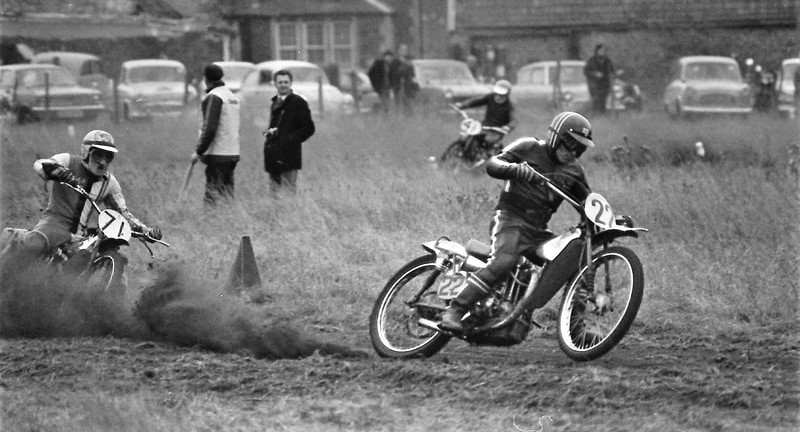No products in the cart.
The Accident Waiting to Happen
A brief history and description
What is Motorcycle Grass Track Racing? Dubbed as “an accident looking for a place to
happen,” the sport evolved in the late 1920’s, with the abolition of racing on the public
highway in the UK. Like scrambling (motor x, as we call it) it moved from the road to
farmers’ fields. Grass Track racing didn’t need a large amount of room, as essentially the
tracks were larger versions of speedway—perhaps only 400 to 900 yards long. With just
two straights and two bends, grass track courses were simple to construct. Grass tracks
were then and now mainly temporary: used just for the day’s racing, then given back to
their agricultural uses. In the early days, conventional road bikes were employed, but as
with all sports and the desire to gain an advantage, the grass track bike evolved; in this
case, very similarly to the speedway bike. Differences arose between the two
applications, primarily due to the varied terrain in grass track. One major difference is
that grass track bikes have both front and rear suspension–to take into account the
variable terrain conditions–whereas speedway bikes have rigid rear ends and only
minimal front suspension, suitable for the flat tracks on which they operate. Furthermore,
grass track bikes have gears, while speedway bikes don’t (speedway machines have no
gearbox; their 500cc engines have enough power, on their short tracks, to use a single
drive/rear sprocket gearing for start through max speed).
In speedway, riders form a team (apart from individual championships), but grass track is
a totally individual sport. Insofar as the way the racing is conducted, speedway has four
riders on the track; grass track can have up to 18 at the start! And, speedway has
developed into just one class: 500cc single cylinder four strokes. In grass track, like
motor x, there are several capacity classes, and also sidecar outfits. This is where it gets complicated; there are both left-hand and right-hand sidecar outfits (they don’t mix!), and
left-hand outfits race anti-clockwise (as per the solo classes) and right-hand outfits race
clockwise. Both types have the sidecar on the left-hand side, but their design and style of
racing is totally different. Don’t forget the Brits are famous for their idiosyncrasies!
Grass track had a much more diverse mixture of both engines and capacities. Grass track
bikes actually reach higher speeds than speedway bikes, because of longer tracks and
mostly better grip. Some bikes would be fitted with speedway engines and it was found
that a two speed gearbox was of benefit, but this was not a normally-functioning gearbox,
as one gear was used only for launching off the start line, and could not be selected again
during the race (I hope this is understandable). Re-purposed road and motor x engines,
which made up the entire grid in the smaller capacity classes, already had gearboxes, of
course.
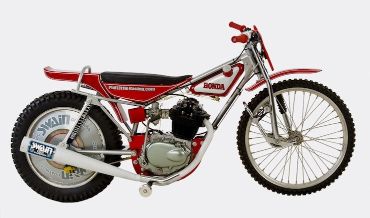
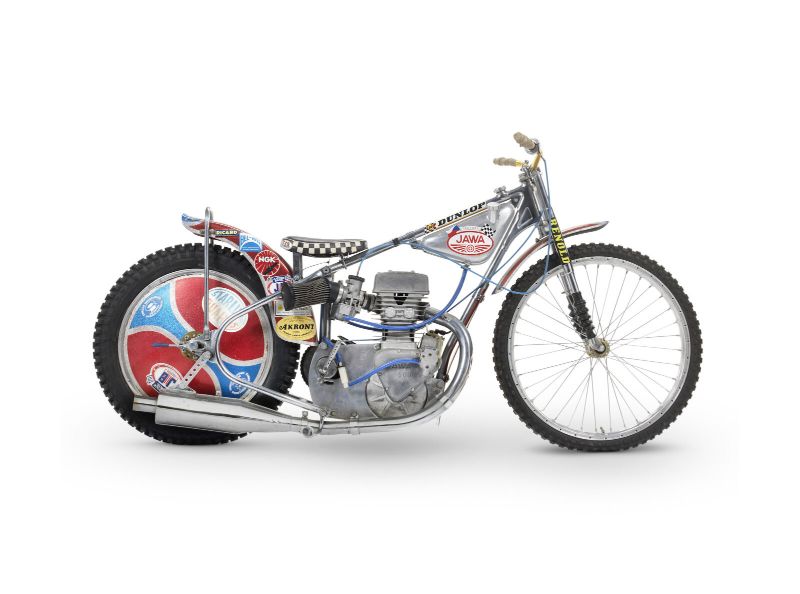
Grass track vs. Speedway engineering. Note presence of suspension, larger seat, and off-the-shelf engine in the grass track bike on the left. On the right is a typical 1970s speedway machine.
It is important to realize that unlike road and motor x racing there were no mainstream
manufactures producing either complete bikes or engines. The entry of motor x riders
with modern engines opened up the eyes of grass trackers to the fact that modern two-
strokes easily had the beating of the traditional BSA 250 four-strokes. Grass track bikes
fitted with these engines then had no problem in beating motor x riders/bikes. Grass track
racers are fairly innovative and exotic engines were installed: I remember a Yam TZ 250
and I think a TZ350 being tried, which gave the rider all kinds of “interesting” moments!
In the sidecar classes it was another world, with modern (70s and 80s) road race multis up
against old supercharged Triumphs alongside Hillman Imp, VW and Saab car engines.
Anything in fact that had more power than the others.
Like speedway, grass track is also practiced on the European continent, resulting in the
injection of local ideas, and off-shoots like sand/beach racing and long track racing have
developed to suit the differing environments.
One more interesting aspect of grass track can be that you’ll never know who might show
up: meetings have a purse, and we all like to make money. Thus, speedway stars have
been known to appear at major grass track events endeavoring to take the prize money!
Rather than look upon this practice as “cherry picking” we chose to view this as an
opportunity: one of the few sports that amateurs get the chance of taking on world
champions!
How is grass track organized, and what happens at a meeting?
Well when I raced back in the 70s and 80s, racing was regulated by the ACU (Auto Cycle
Union) and the UK split into centres (Editorial note: similar to the creation of ‘regions’ in
American AMA-governed racing). Events were organized by local motorcycle clubs,
whose members would put on all sorts of competitions: road racing, trials, motor x, hill
climbs, rallies, etc. All this work was done voluntarily, for the pleasure of UK racers. I
raced in both the Southern and South Eastern centres. Each centre had its own list of
riders and you were issued a racing number appropriate to that centre. From a book of
event entry forms you’d send your money and details, and hope you got accepted. In the
60s, 70s and 80s the number of prospective competitors often exceeded the limit put on
each event, so you had to get your entry in quick to ensure a ride.
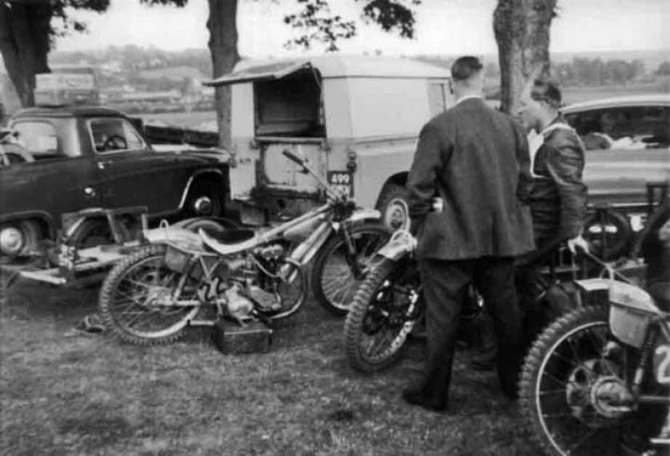
The pits at a 1965 English grass track event (photo: Rob Davies, Vintage Bike)
It was very popular, with often two events in one centre on the same day (Sunday). At major events, up to 20,000 spectators would attend. Events didn’t usually start until at least midday, this was to take into account that usually a local church service would be underway prior to this time (the sound of revving engines didn’t do much for the sermon!). You would get your bike(s) scrutineered, to ensure they not only complied with regulations, but were safe to race. Then, never having seen the track before (remember, most tracks are temporary—built for a single meeting, and then allowed to go back to agriculture), you got a maximum of 4 laps practice (about 2 minutes) to familiarize yourself with the surface texture, grip and the dips and bumps (we are not talking flat here!). If you were entered in several capacity classes you got to practice for each, so that was actually a slight advantage. In the larger capacity classes the bikes were bump started. Don’t forget these are high compression engines running on methanol; it would be a brave man to kick start one!
Get ready . . . get set . . . GO!
Unlike motor x, where the start is controlled by lights or a fall-down gate, or speedway,
which is controlled by fly up tape, grass track uses two lengths of elasticated tape. These
are attached at the centre of the start line by a trigger on a post, and the starter stands in
front of the post, facing the riders. With his hands on the trigger behind him, throttles are
opened to the max, the starter triggers the tapes (which fly off to the sides of the track),
and the clutch is dropped!
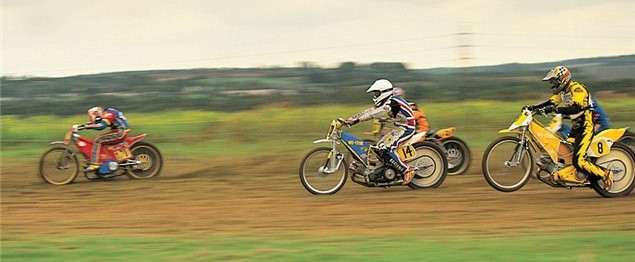
A modern grass track start (photo: Visor Down)
Once the racing started, there would be heats for each class, followed by semi-finals and
finals. It would be all over in about 5 hours, whereupon everyone was expected to help
take the track down. The track itself was like this: The inside and outside of the track
were designated by short stakes, driven into the ground, and at more important meetings
these would have flags attached. To “protect” the spectators there was a triple row of
ropes held up, with fence stakes hammered into the ground. This was quite effective with
stopping an out of-control-machine—providing it stayed near the ground—but not so
good when a motorcycle is launched skyward, and hurdles the ropes!
Decline, but hopes for the future
Grass track was extremely well supported up until the 90’s, when it began to go into
decline. This paralleled the fortunes of speedway, which was the second most popular
sport in the UK in the 80’s, but has struggled in recent years. There was a fair cross-over
of both spectators and riders between the two sports, as well. Why did such exciting
sports decline? I’m sure that many would love to know the answer, but my feeling is it
was partly due to lack of innovation, infrastructure investment both for track and
spectator facilities and loss of mainstream TV coverage. It also helps I think if niche
sports have a few “characters” involved, I’m thinking of the likes of Barry Sheene and
James Hunt who interested the general public not just with their racing, but also, and
more critically their “outside” activities. All publicity being good publicity.
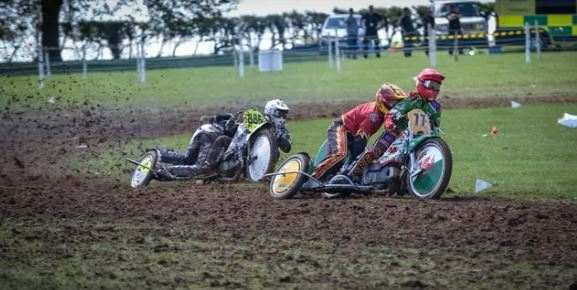
Modern sidecars in action. Yes—what could possibly go wrong, here? (photo: Bewdley Motorcycle Club)
Both speedway and grass track are not easy sports to get involved in; it’s not like road
racing where the bikes raced are very little different in appearance to those used on public
roads, so can be related to. Speedway bikes can only be ridden on purpose built tracks
(which are becoming fewer) and only anti-clockwise, so not what you would experience
in the “real” world. Not an easy sport to sell!
Grass track also profited by motor x riders having a go, initially, when the early Japanese
designs emerged. But, as motor x designs moved towards bikes with increased
suspension (so they could cope with more “aerial” time), their geometry meant they no
longer were competitive on “flat” tracks.
In the last few years there has been a bit of a resurgence, with some meetings catering for
quads, junior racing and a new class powered by Honda 140cc engines.
I’ve obviously only touched on the strange sport of grass track, and these remembrances
reflects only my personal experiences of the 60’s, 70’s and 80’s . . . so they are quite
subjective.
For a visual recent history it is worth visiting a Youtube channel documenting Grass
Track racing over the last thirty years
at https://www.youtube.com/user/BOB231158 (There are over a thousand videos
featured!)
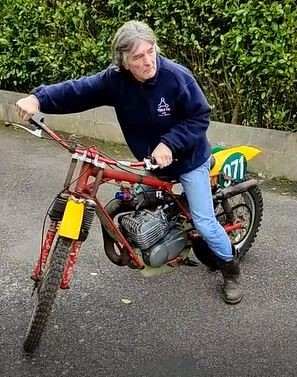
The author on his home-built Harley MX250-engined grass tracker (photo: the author)
Join us in a few weeks for Part II of Jon’s story of one of his own home-built grass
trackers—powered by Harley-Davidson MX250 engine!

